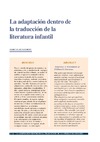Identificador persistente para citar o vincular este elemento:
https://accedacris.ulpgc.es/handle/10553/7533
| Campo DC | Valor | idioma |
|---|---|---|
| dc.contributor.author | Pascua Febles, Isabel | en_US |
| dc.date.accessioned | 2012-06-14T04:00:32Z | - |
| dc.date.accessioned | 2018-04-25T13:49:28Z | - |
| dc.date.available | 2012-06-14T04:00:32Z | - |
| dc.date.available | 2018-04-25T13:49:28Z | - |
| dc.date.issued | 1999 | en_US |
| dc.identifier.issn | 1134-5306 | en_US |
| dc.identifier.uri | https://accedacris.ulpgc.es/handle/10553/7533 | - |
| dc.description.abstract | Tras el estudio del género de cuentos y su estructura, y de la ampliación del concepto de «intertextualidad cultural», se realizó el análisis comparativo-contrastivo de las convenciones textuales de los cuentos españoles e ingleses, pudiendo así evaluar las traducciones de los cuentos ingleses de animales. Tras ello, demostramos que las adaptaciones pueden dividirse en tres tipos: necesarias, admisibles e inadmisibles. Y ello, a partir de la no coincidencia de los conocimientos cognitivo-culturales, de las normas de comportamiento verbal y no verbal, y de las convenciones textuales. El interés científico de nuestro trabajo consiste en que, además de ser el primero en analizar y evaluar las traducciones de cuentos infantiles, su principio metodológico puede aplicarse a cualquier otro tipo de texto, y a la didáctica de la traducción, abriendo nuevas líneas de investigación. El interés social está en que es un trabajo muy útil, sirviendo de pauta y de orientación a los traductores profesionales a la hora de traducir cuentos de animales al español, desde cualquier idioma, no sólo inglés. | en_US |
| dc.description.abstract | The genre and structure of popular tales for children were subjected to analysis and the concept of æcultural intertextualityÆ was broadened to englobe the same. Thereafter, a comparative-contrastive analysis of the textual conventions observed in Spanish and English fairy tales for children was carried out. This allowed a qualitative evaluation of the Spanish translations of English tales. The adaptations were grouped into three categories: necessary, passable and completely inadmissable, according to the degree of cognitive- cultural coincidence, norms of verbal and non-verbal behaviour and textual conventions. The scientific interest of the work consists in its applicability as a methodology to all other types of texts, thus making it a valuable tool for the teaching of translation whilst also opening up new fields of research, not only restricted to the translation between Spanish and English. | en_US |
| dc.format | application/pdf | es |
| dc.language | spa | en_US |
| dc.relation.ispartof | Vector Plus | en_US |
| dc.source | Vector Plus [ISSN 1134-5306], n. 13, p. 36-47, (1999) | en_US |
| dc.subject | 570112 Traducción | en_US |
| dc.subject | 570108 Lenguaje infantil | en_US |
| dc.title | La adaptación dentro de la traducción de la literatura infantil | en_US |
| dc.title.alternative | Adaptation in Translations of ChildrenÆs Literature | en_US |
| dc.type | info:eu-repo/semantics/article | en_US |
| dc.type | Article | en_US |
| dc.compliance.driver | 1 | es |
| dc.identifier.absysnet | 231633 | - |
| dc.identifier.crisid | 941 | - |
| dc.description.lastpage | 47 | en_US |
| dc.description.firstpage | 36 | en_US |
| dc.investigacion | Artes y Humanidades | en_US |
| dc.rights.accessrights | info:eu-repo/semantics/openAccess | es |
| dc.type2 | Artículo | en_US |
| dc.description.numberofpages | 12 | en_US |
| dc.utils.revision | Sí | en_US |
| dc.identifier.supplement | 941 | - |
| dc.identifier.ulpgc | Sí | en_US |
| item.grantfulltext | open | - |
| item.fulltext | Con texto completo | - |
| crisitem.author.dept | GIR Traducción e Interpretación, Interculturalidad, Lenguas Aplicadas y Literatura de Viajes | - |
| crisitem.author.orcid | 0000-0002-1595-4312 | - |
| crisitem.author.parentorg | Departamento de Filología Moderna, Traducción e Interpretación | - |
| crisitem.author.fullName | Pascua Febles, Isabel | - |
| Colección: | Vector plus. n.13, 1999 Artículos | |
Visitas
863
actualizado el 11-ene-2025
Descargas
2.075
actualizado el 11-ene-2025
Google ScholarTM
Verifica
Comparte
Exporta metadatos
Los elementos en ULPGC accedaCRIS están protegidos por derechos de autor con todos los derechos reservados, a menos que se indique lo contrario.
